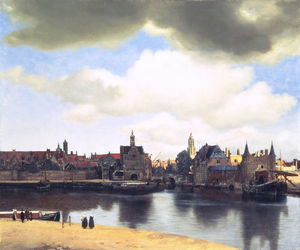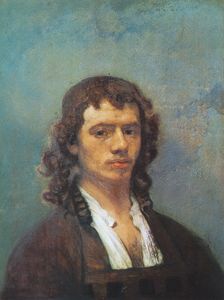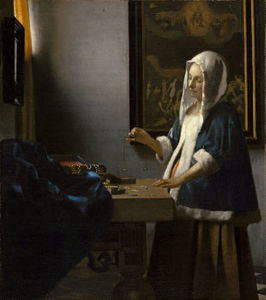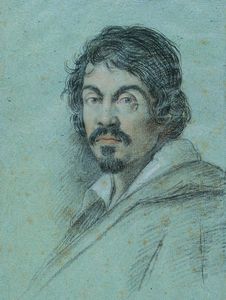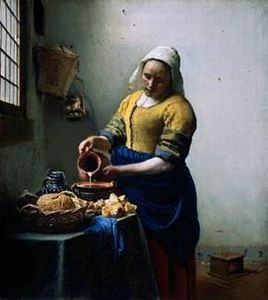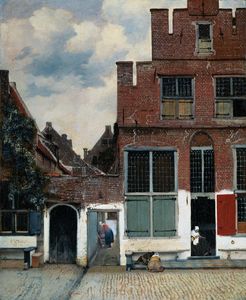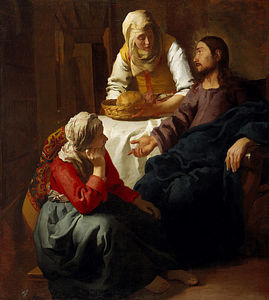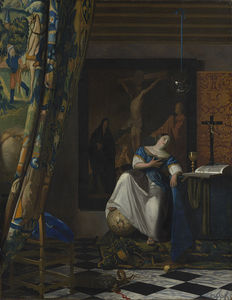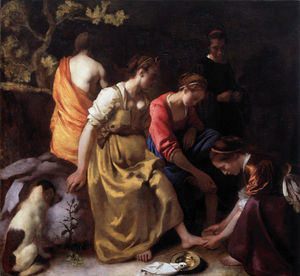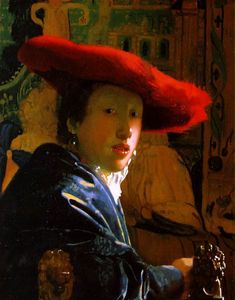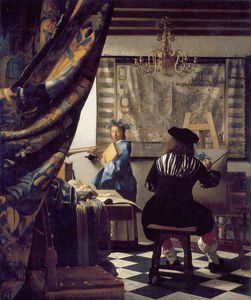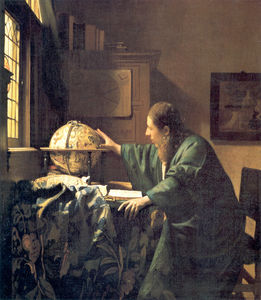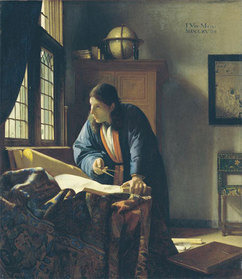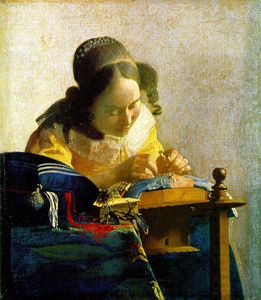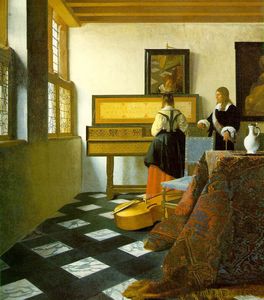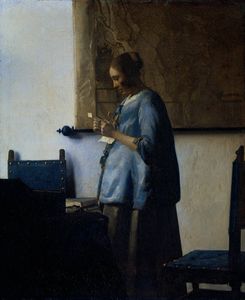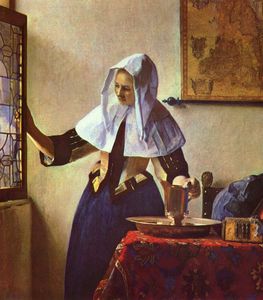Johannes Vermeer
- Short Name:
- Vermeer
- Date of Birth:
- 31 Oct 1632
- Date of Death:
- 15 Dec 1675
- Focus:
- Paintings
- Mediums:
- Oil
- Subjects:
- Figure, Landscapes
- Art Movement:
- Baroque
- Hometown:
- Delft, Netherlands
- Johannes Vermeer Page's Content
- Artistic Context
- Biography
- Style and Technique
- Who or What Influenced
- Works
- Followers
- Critical Reception
- Bibliography
Johannes Vermeer Artistic Context
Vermeer is famed for his technical talents and contribution to the art world during the 17th century. He was a master of chiaroscuro and realism painting and he drew inspiration from the Italian Baroque era.
Vermeer was one of a number of artists from Delft, a small town that made its living from breweries, porcelain and tapestries. This group of artists is often referred to as "the School of Delft" although few of them were actually born there. These artists inspired one another but Vermeer developed his own style that surpassed his peers and allowed him to rank alongside Dutch masters such as Rembrandt and Hals.
Vermeer's subject matter was very unique in that he was able to create the most thought-provoking images from the most mundane moments of daily life. His skill and ability made him a leader and revolutionary of the Baroque era.
Johannes Vermeer Biography
Johann&egravzzz;s Vermeer was born to Reijnier Janszoon and Digna Baltens, middle-class innkeepers and prominent silk weavers in the city of Delft. Vermeer's father was a member of the St. Luke's Guild, where he traded and sold various paintings. It was from this profession that Johannes would learn all about art.
Johannes Vermeer later became part of the Guild of St. Luke. It is believed that Vermeer apprenticed under Leonart Bramer or Carel Fabritius but no evidence can really verify this. Some scholars believe that Vermeer was taught by the Catholic painter Abraham Bloemaert.
In April 1653, Vermeer married Catharine Bolnes, a wealthy Catholic woman and they had fifteen children together but sadly, four died at birth.
Catherine modeled for many of her husband's great works including Woman Holding a Balance and Woman Reading a Letter. He also included various images of his children in his paintings, such as The Little Street.
The couple are believed to have lived a happy married life until Vermeer's untimely death in 1675 from what is assumed to be a stroke.
During his lifetime, it's thought that Vermeer completed a total of thirty-five paintings, though many others that are thought to be his remain unattributed. Much can be said of Vermeer's personality traits within his works such as his affinity for the domesticity of home life and the values instilled within Christian life in the Netherlands.
Johannes Vermeer Style and Technique
Most of the dates given to Vermeer's paintings have been estimates by art historians as there is so little information about the artist himself.
1650-1659:
Vermeer's love of the Italian Baroque style and subject matter can be seen in his earliest works to date. His painting technique and style was also shaped by his time at the Guild of St. Luke in Delft which was strongly influenced by the Art School of Antwerp. This Art School greatly admired the works of Caravaggio and other great masters.
1660-1669:
The majority of Vermeer's masterpieces were created during this period and some took up to three years to complete. Vermeer's paintings became more intense during this time due to the financial difficulties he was facing.
Vermeer created new ways of viewing paintings with his profound and complex compositional techniques that took the viewing process to new levels. He created various optical illusions to make three dimensional objects and space.
The artist's use of the camera obscura is most noted in this period.
A realist painter, Vermeer focused a great deal on chiaroscuro and became a master in using this technique. He delighted in the technicalities of the camera obscura that had emerged in Dutch markets at this time and was an avid fan of using various lens and glass contraptions to discover new forms of capturing light in various contexts.
1670-1675:
Vermeer's life wass cut short during this decade as he died suddenly of what is believed to be a stroke on 15 December 1675.
The last five years of his career showed him continuing to create astounding art works as he strived to find new methods in recreating light and shadow to define space. Vermeer also made the influences of the old masters style adaptable to his own choice of subject matter.
Who or What Influenced Johannes Vermeer
Delft was a southern province under Spanish rule and this greatly impacted on the art market. Many artists born in Delft went unknown and wealthier patrons all fled to northern Holland. Thus, artistic content in Delft centered on images of the city, domesticity and local surroundings and most paintings were created in the contexts of Christian morals and values.
Being raised Protestant, Vermeer painted everyday images and his surroundings due to the fact that Protestant Dutch society held the natural aspects of life in high esteem. Vermeer strived to depict the beauty in the most mundane aspects of daily life. He was also a realist and in many of his paintings he depicted black and white tiled floors in houses which was a popular style at the time.
In general, the Dutch preferred dark backgrounds with a focused subject in the foreground. Vermeer liked this tradition and played with various light sources as it competed with dark spaces through natural and non-natural lighting.
Dutch society also relished in scenes of domesticity that instilled a form of homogeny. Many Delft inhabitants prided themselves on their high standards of education and refinement and had developed a taste for art that reflected such attributes.
The Guild of St. Luke:
The Guild of St. Luke was largely influenced by Classicism and this shows in Vermeer's works and how he portrays his subject matter, as demonstrated in works such as Diana and Her Companions. Furthermore, the way Vermeer presents his subjects in an idealistic manner from an objective perspective also reinforces the influence of Classicism.
Catholicism in Delft :
Due to the fact that Vermeer married a Catholic, he was greatly inspired by Italian masters such as Caravaggio. His mother-in-law, Maria, was an avid collector of many Catholic artist's work from Utrecht. The school of art in Utrecht closely followed Caravaggio's work and provided inspiration for Delft artists.
Vermeer's paintings such as Christ in the house of Martha and Mary and Diana and Her Companions show the artists' affiliation to biblical themes and classic mythological images as well as similarities to the Italian Baroque style.
Johannes Vermeer Works
Johannes Vermeer Followers
Since the rediscovery of Vermeer's works in the 19th century, his reputation has flourished. His style has been imitated by painters such as Simon Duiker and Han van Meegeren. Salvador Dalí even created his own version of The Lacemaker.
Additionally, Vermeer's Girl with A Pearl Earring has inspired a novel by Tracy Chevalier and a film of the same name.
Johannes Vermeer Critical Reception
During Life:
Vermeer established himself as a competent artist who produced works that were in demand by the people of Delft and his work was recognized by The Hague. He made the art of chiaroscuro his own and developed many innovative techniques during his career, setting himself apart from his contemporaries.
Vermeer was not the most prolific of artists, with just thirty-five paintings to his name, though, many others that are believed to be his remain unattributed. Furthermore, the fact that his hometown of Delft was under Spanish rule did not help his career and consequently, Vermeer faced significant financial problems like so many artists at this time.
After Death:
After Vermeer's death in 1675, his paintings became somewhat insignificant and it was not until the 19th century that renewed interest in his work came about after three of his earliest works were rediscovered, one of these being Diana and Her Companions.
However, there was hardly any mention of Vermeer in Arnold Houbraken's major source book on 17th century Dutch painting (Grand Theatre of Dutch Painters and Women Artists) and he was overlooked in subsequent surveys of Dutch art for almost 200 years.
Today Vermeer is considered one of the greatest artists of the Dutch Golden Age.
Johannes Vermeer Bibliography
To read more about Vermeer and his work please refer to the recommended reading list below.
• Arasse, Daniel. Vermeer: Faith in Painting. Princeton University Press, 1996
• Binstock, Benjamin. Vermeer's Family Secrets: Genius, Discovery, and the Unknown Apprentice. Routledge, 2008
• Cant, Serena. Vermeer and His World: 1632-1675. Quercus, 2009
• Liedtke, W. Vermeer and the Delft School (Metropolitan Museum of Art). Yale University Press, 2001
• Snow, E. A Study of Vermeer. University of California Press, 1994
• Steadman, Philip. Vermeer's Camera: Uncovering the Truth Behind the Masterpieces. Oxford Paperbacks; New Ed edition, 2002

